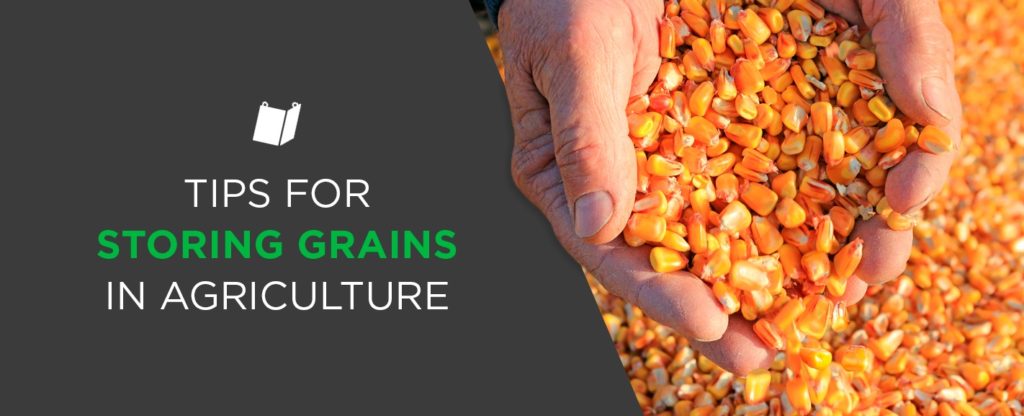Tips for Storing Grains in Agriculture
A practice that is gaining traction in the agricultural industry is using bags to store grain. Before you choose to move forward with putting this concept into action, you’ll want to ensure you fully understand how to properly store your grain.
Grain Storage Solutions
To help you make the best decision for your company, we have compiled a few tips that will help you store your grains properly and answer questions you may have about the process.
1. Storing Bags
You will want to have access to your bags in all seasons and weather conditions, so keep this in mind when you’re selecting where you will store your bags. Ideally, the location where you store your bags will be alongside a road or in a well-drained, firm area. The site you choose should have plenty of truck access, along with providing the ability to load and unload equipment.
With this in mind, you’ll want to store the bags near a surface that will give your trucks and other wheeled machines sufficient traction, as this will make loading and filling grain bags much easier. Poor traction can make the process unnecessarily challenging.
Be mindful of the location of any trees, as well. Avoid storing grain bags beneath trees, as branches may fall onto them and stress or puncture the grain bags.
2. Choosing the Best Surface
The area where you store your grain bags should be slightly sloped, firm and elevated, so there is no chance the bags will be at risk of flooding. If the area doesn’t drain naturally, you’ll want to dig drainage channels or find another site.
Before transporting the grain bags to your chosen site, make sure you thoroughly scrape the ground for sticks, weeds and stones that may be able to puncture the bags. Scrape lightly, as you don’t want to loosen the soil or make it less firm for the storage of your grain bags.
3. Preparing for Birds and Rodents
If you’ll be storing your grain bags in a field, you may want to position the bags in a line. By setting up your bags this way, you can prevent pests like rodents and other animals from using your grain bags for shelter to protect them from predators and weather. You may also want to spray the area for grass and weeds to reduce the habitat for rodents.
4. Dealing With Insects
Fortunately, this method of bulk storage of grains virtually eliminates insects and fungal diseases, even without using chemicals. That’s because after you seal a grain bag, the level of oxygen decreases and the level of carbon dioxide increases. Because you won’t be dealing with insects or chemicals, there will be less necessary labor, less toxicity and higher profits.
5. Making the Grain Bags Last
The amount of moisture in your grain can impact how long you can successfully store grain in your bags. For dry grains, you should be able to store them in a grain bag until the next growing season without any loss in quality. Do what you can to keep the conditions dry for your grain. High-moisture grains do not store well for long.
6. Repairing Holes
Check your grain bags regularly, at least once a week, for any punctures or tears. You’ll want to seal any holes as quickly as possible to prevent moisture from getting inside the bag. Checking on your bags immediately following a storm is vital.
For small damages, you can repair the grain bag with tape from the bag’s manufacturer. If the damage is too extensive to fix with tape, you’ll want to opt for emptying the bag and loading the grain into a new one.
7. Cleaning Up
After you empty your grain bags, you may want to restore the site to its initial state. If all went well with your storage location, you should be able to re-use that site for grain bag storage.
How to Store Grain
Farmers have a few options for storing grain, and maybe you’re having trouble deciding which is the best choice for you. The priorities for any storage method are moisture levels, temperature control and safety.
1. Grain Piles
You’ll most often find grain piles at coops and grain elevators. If you’re facing a grain storage issue, a grain pile may be a short-term solution. The major drawback of grain piles is that they are entirely vulnerable to the elements. Grain piles can suffer moisture damage, and wind does not properly aerate a grain pile, despite what some may initially assume.
Covers and aeration systems are available to protect a grain pile from weather damage, though you’ll want to weigh the costs of the aeration system and cover against the cost of the spoiled grain. If you are using an aeration system, make sure your grain piles are close to an electrical outlet. Keep piles away from flood areas to avoid moisture. Include proper drainage and a substance with low permeability on the ground surface, such as cement, lime or asphalt.
2. Old Grain Bins
Grain bins can protect grains from precipitation and allow for moisture and temperature control. In a tight spot, farmers may decide to use old grain bins. If you find yourself in this position, you’ll want to make sure you’re paying attention to functionality and safety. Some bins may have a perforated floor, and others may come with in-floor aeration.
For bins of more than 3,000 bushels, add a temperature control system via aeration tubes if aeration doesn’t already exist. You may also want to include roof vents and fan covers. Before using an old bin, examine them for structural integrity. That means making sure you have sanitized and tightly sealed everything.
3. Grain Bags
While grain bags can be susceptible to tears and moisture, they are excellent for storing dry grains. They can keep out pests and are easy to repair and transport. For a reliable, long-lasting storage method, grain bags are an excellent option.
Advantages of Using FIBCs to Store Grain
FIBCs, also known as bulk bags, provide many benefits when it comes to storing grain.
1. Customizable
These bulk bags are versatile enough to meet your exact needs for grain storage, including several top options and spout sizes.
2. Protected Against Pests
Rodents and insects can damage and contaminate your grain. That’s why you can buy FIBCs with a fully sealed design. The polypropylene layer also makes chewing through the bag much more challenging for rodents.
3. Protected Against Moisture
Bulk bags can come with a coating to protect your grain from moisture. This polypropylene film can be either on the outside or inside of the bag, along with an optional polyethylene liner for even more protection against moisture.
4. Minimal Needed Space
Bags don’t take up as much as space as a bin or grain pile, but even better, FIBCs can also stack. By stacking your bulk containers, you can minimize the storage space they require even more.
5. Minimal Maintenance
If any bag becomes compromised, you can also easily isolate that container so the infestation doesn’t spread. Your FIBCs will be low-maintenance and save you money.
Your Source for Affordable Reconditioned Bags
Choose used bulk bags from Bulk Bag Reclamation for all your grain storage needs. We recondition, repair and recycle used bags and FIBCs. Contact us or request a quote today!



